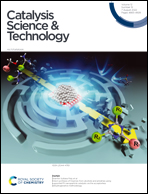Relationship between ZSM-5 pore modifications and gallium proximity and liquid hydrocarbon number distribution from ethanol oligomerization†
Abstract
Jet fuel from petroleum provides energy densities and other attributes vital for aviation but adds to greenhouse gas emissions. Biomass provides an inexpensive resource that is uniquely suited for large-scale conversion into low carbon footprint sustainable aviation fuels (SAFs) for the immediate future and likely longer. Through a pool mechanism, novel consolidated alcohol deoxygenation and oligomerization (CADO) ZSM-5 catalysts offer a low-cost, one-step, complete conversion of biomass ethanol into hydrocarbons without adding hydrogen. However, CADO products mostly contain less than 8 carbon atoms while jet fuel includes up to 16, likely restricting jet fuel blending to 50% or less. To overcome this limitation, the effectiveness of reacting ZSM-5 with 0.2, 0.6, 0.8, and 1.0 M sodium hydroxide concentrations over a range of temperatures and times was evaluated for enhancing the carbon number range. X-ray diffraction, N2-physisorption, X-ray photoelectron spectroscopy, H2-TPR, and STEM showed that treatment with 0.8 M sodium hydroxide at 60 °C for 0.5 hours increased pore volumes and metal–support interactions more than lower concentrations while retaining crystallinity better than 1.0 M treatment. The larger pores enhanced 5 wt% gallium oxide migration into ZSM-50.8M channels and promoted strong interactions between gallium oxide and the support which, coupled with the retained crystallinity and greater capacity for larger molecules, increased liquid hydrocarbon yields (LHYs) from pure ethanol to 46.1% and C9–C10 aromatics selectivity to 45.8%, the first reported direct increase in C9–C10 aromatics selectivity from ethanol. In addition, cofeeding 60% water with ethanol further enhanced the LHY and C9–C10 aromatics selectivity to 53.1% and 55.1%, respectively, while extending the catalyst stability.



 Please wait while we load your content...
Please wait while we load your content...